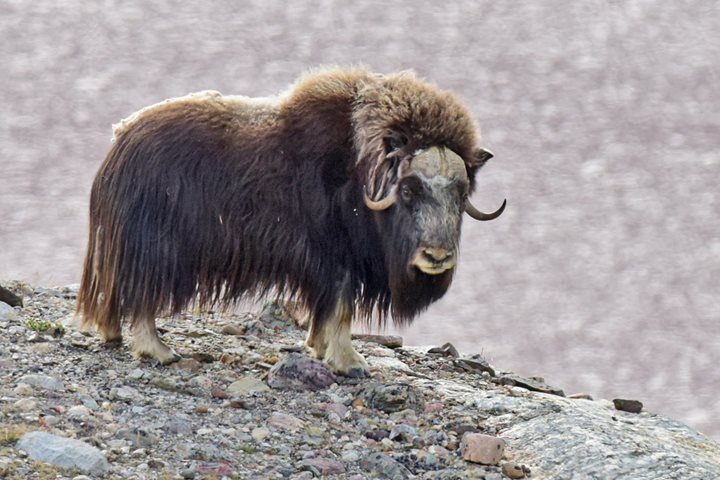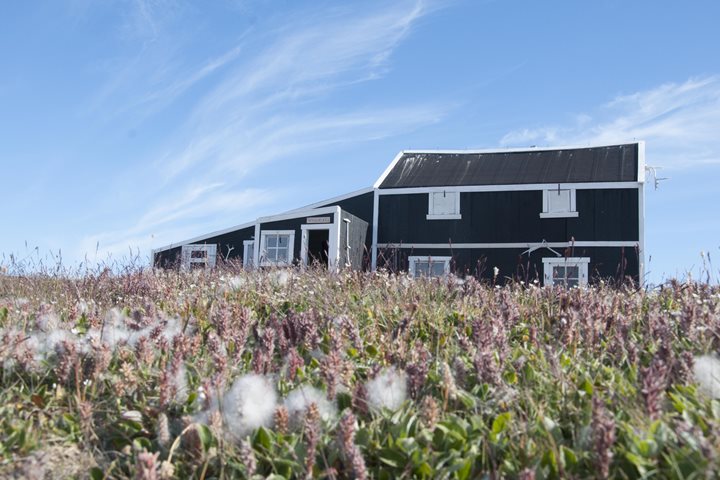The southern cliffs of Devon Island rose from the waters of Lancaster Sound like the ramparts of some mythological citadel. Consisting of alternating layers of limestone, shale, and sandstone, these ancient sedimentary rocks contain a deep-time narrative that can be read by geologists like the pages of a book. We spent the morning exploring the terrain at Radstock Bay. This is a multi-faceted landscape with interesting natural and cultural elements. Immediately we were struck by the number of fossils in the rock fragments that make up a series of raised beaches here. Being slightly harder than the surrounding rock matrix in which they are embedded, fossils tend to weather at a slower rate. As a result they often stand proud of the rock surface and can be examined in detail. They were in profusion in a wide variety of forms including solitary and colonial corals, crinoids, and nautiloids, and we spent a very pleasant time searching for them as we pottered about on our walks.
One group made their way to the top of Caswell Tower, a towering headland some 650 feet high, which afforded a panoramic vista of the surrounding seascape. Freeze-thaw action is the main weathering process here in the Canadian Arctic and as a result impressive screes have accumulated against the lower levels of the cliffs. Erstwhile human presence is evident from the remains of both summer and winter houses of the Thule people who eked out a living here from 1200 A.D. onwards. Very much dependent on the bounty of food provided by the sea, they incorporated bowhead whale bones in their houses, using skulls and ribs to support the animal-skin roofs. A little distance inshore we explored the remains of their houses and pondered the world they inhabited, with it ever-present dangers and challenges.
During lunch the National Geographic Explorer repositioned to Erebus and Terror Bay to facilitate a visit to Beechey Island, an iconic site in the High Arctic. In 1845 Sir John Franklin, commanding two ships and 128 officers and men, embarked on what was then the best equipped and largest expedition ever mounted by the British in the quest of the Northwest Passage. Having made their way as far northwest as Bathurst Island they were forced to retrace their route and by September 1845 had to overwinter by Beechey Island. The winter of 1846 was incredibly severe and between January and April three of the expedition’s crewmen died. That spring the ships sailed towards the west. Not a single member of the expedition was to survive. The fate of Franklin and his crew became an obsession. In the 1980s a scientific team, headed by Canadian anthropologist Owen Beattie, exhumed the bodies of the three Franklin seamen interred on the Beechey Island. The frozen conditions in which they were buried meant that the bodies were extremely well preserved and results confirmed that they had all died of tuberculosis and possibly pneumonia. In addition tissue samples taken showed massively inflated levels of lead in the crewmen. Lead poisoning leads to both physical weakness and a breakdown in the ability of a person to think clearly and logically. In the severe, harsh Arctic environment this no doubt would have been catastrophic for the expedition. The source of the lead was the thick strip of solder which sealed the tins of food taken on the ships for the expedition. Standing beside the three forlorn graves of these Victorian sailors one could not but be struck by the desolate character of the surrounding landscape. Windswept and cold even today in August, we found it difficult to imagine the conditions in which the crew spent that winter here at Beechey.
May this trio, and all of the explorers whose remains lie scattered across the Arctic tundra, rest at ease in their celestial hammocks.







